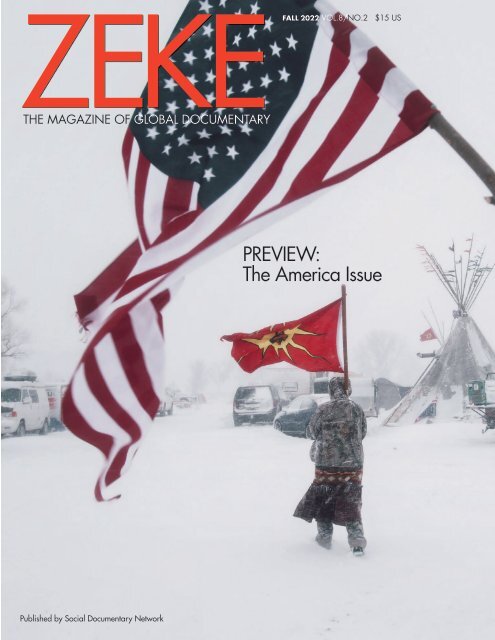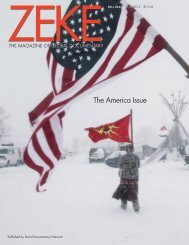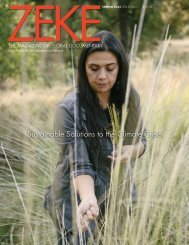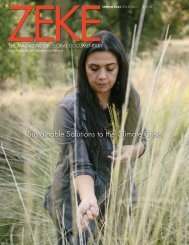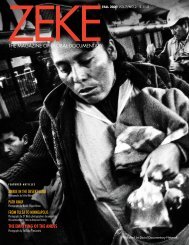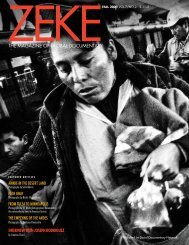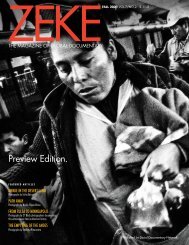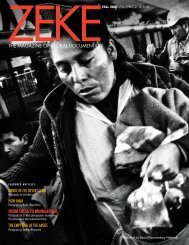You also want an ePaper? Increase the reach of your titles
YUMPU automatically turns print PDFs into web optimized ePapers that Google loves.
<strong>ZEKE</strong>FALL <strong>2022</strong> VOL.8/NO.2 $15 US<br />
THE MAGAZINE OF GLOBAL DOCUMENTARY<br />
PREVIEW:<br />
The America Issue<br />
Published by Social Documentary Network<br />
<strong>ZEKE</strong> FALL <strong>2022</strong>/ 1
The<br />
AMERICA<br />
that in our industry and farms and schools<br />
and popular culture and the fine arts we<br />
have created. These achievements must<br />
be embraced while this nation also faces<br />
poverty, addiction, ignorance, and violence<br />
on a scale unknown in most of the<br />
developed world.<br />
As a nation, we are trying to find our<br />
center and regroup, rebuild, redefine<br />
our way finally into a new century that<br />
America. We endure because the was born on 9/11—an event that set<br />
land of the free and home of the brave us back a century, not because of what<br />
was an idea of its time, imperfect in its happened to us but because of how we<br />
exclusions, but a beacon for the modern<br />
world to embrace—a notion that The photographs on the next 46<br />
responded with hubris and arrogance.<br />
all people are endowed with inalienable pages give us a glimpse of who and<br />
rights. Inspiring as this concept may be, what we are today, what we must overcome,<br />
what we can achieve. Our current<br />
there has always been a heavy burden<br />
of detractors who never believed in the president is fond of saying that America<br />
ideal and only cherished their own privilege<br />
in this new land of opportunity. its mind to it. More important though in<br />
can achieve anything it wants if it puts<br />
Divided like this only once before, we reaching our potential is if we can agree<br />
are now walking a delicate path.<br />
on some basic principles and right now<br />
This is the America we seek to this nation is having a hard time doing<br />
describe in this issue of <strong>ZEKE</strong>.<br />
just that.<br />
While the term Black Lives Matter It is in this light that we are so proud<br />
was coined just nine years ago, there to present this body of work by 18 photographers<br />
on the theme of America.<br />
was always a deep sentiment of support<br />
for what it means. Yet the fact remained<br />
that Black lives did not matter to the vast<br />
majority of people who just went on in<br />
their (our) ways.<br />
There has always been a darker and<br />
visible underside to this nation as evidenced<br />
in the KKK, the American Nazi<br />
Party, anti-immigrant groups of all kinds,<br />
as well as a softer manifestation of racism<br />
and exclusion in local city councils, state<br />
legislatures, in our places of worship, and<br />
in the Supreme Court of the land.<br />
A nation founded in the idea of human<br />
potential was able to deliver and we see<br />
2 / <strong>ZEKE</strong> FALL <strong>2022</strong><br />
ISSUE<br />
Robin Fader<br />
Amber Bracken<br />
Cheryl L. Guerrero
Susan Ressler<br />
Kevin McKeon<br />
Anthony Karen<br />
Nick Gervin<br />
<strong>ZEKE</strong> FALL <strong>2022</strong>/ 3
Childersburg, Talladega County, Ala.<br />
Sunshine turns soil in the Commons<br />
Community Workshop garden. 2020.<br />
As a response to national division and<br />
the COVID-19 pandemic, Sunshine<br />
and her husband created the Fearless<br />
Communities Initiative where they<br />
maintain a community garden, host<br />
trade days, and celebrate “solidarity<br />
and strength” while regularly vocalizing<br />
opposition to vaccines and promoting<br />
far-right conspiracy theories.<br />
What Has Been<br />
Will Be Again<br />
Jared Ragland<br />
From Indigenous genocide to<br />
slavery and secession, and<br />
from the fight for civil rights to<br />
the championing of MAGA ideology,<br />
the state of Alabama has<br />
stood at the nexus of American<br />
identity. Begun in fall 2020, the<br />
ongoing project, “What Has<br />
Been Will Be Again,” has led<br />
photographer Jared Ragland<br />
across historic colonial routes<br />
including the Old Federal Road<br />
and Hernando de Soto’s 1540<br />
expedition to bear witness to<br />
and connect with individuals<br />
and communities plagued by<br />
generational poverty, environmental<br />
exploitation, and social<br />
injustices.<br />
4 / <strong>ZEKE</strong> FALL <strong>2022</strong>
<strong>ZEKE</strong> FALL <strong>2022</strong>/ 5
8 / <strong>ZEKE</strong> FALL <strong>2022</strong>
In my “America” series,<br />
an ongoing project, I<br />
attempt to portray a<br />
cross-section of a country<br />
filled with overwhelming<br />
pride yet tinged with<br />
sadness and confusion.<br />
To me, the people I photograph<br />
are almost lost<br />
in their own fairy tale. I<br />
try to capture my subjects’<br />
beauty and spirit,<br />
as well as the simplicity<br />
of their surroundings.<br />
After all, I have deep<br />
respect for them, for it is<br />
my fairy tale too, one that<br />
I strived to be a part of<br />
growing up in the Middle<br />
East. It reflects the<br />
movies I watched and<br />
yearned to be a part of …<br />
it is MY America.<br />
US of A Color<br />
Ghada Khunji<br />
<strong>ZEKE</strong> FALL <strong>2022</strong>/ 9
In March 2020, I started working<br />
on a new personal project “COVID-<br />
19 in Black America.” From March<br />
until August 2020, I documented a<br />
group of Black doctors and nurses<br />
providing free COVID-19 tests in the<br />
Black communities of Philadelphia<br />
and surrounding areas. I am now<br />
creating environmental portraits of<br />
Black and brown-skinned people<br />
who have had first-hand experience<br />
with having COVID-19 and recovered,<br />
have lost family members who have<br />
died from the disease, have been<br />
mentally challenged by the year of<br />
being socially isolated, and finally<br />
Black and brown-skinned people who<br />
have figured out how to adjust to the<br />
challenge and made a new pathway.<br />
COVID-19 in Black America<br />
Raymond W Holman Jr<br />
12 / <strong>ZEKE</strong> FALL <strong>2022</strong>
Both of her parents spent time in the hospital after<br />
developing COVID-19, and her mother died from<br />
it. The entire family was in shock when she died,<br />
since she rarely experienced illness. The day we<br />
created this image, the intention was to also create<br />
images of her father, but because he was home still<br />
not feeling well, on oxygen and mourning the loss<br />
of his wife, I decided not to create those images.<br />
<strong>ZEKE</strong> FALL <strong>2022</strong>/ 13
Lost: A Portrait of<br />
Addiction<br />
Virginia Allyn<br />
22 / <strong>ZEKE</strong> FALL <strong>2022</strong>
Addiction could be called a plague. It<br />
blights the land. It ravages lives. Flyers for<br />
the missing ask, “Have You Seen Me?” The<br />
toll it takes is devastating. lt is visible night<br />
and day. In Philadelphia, the poorest of our<br />
nation’s largest cities, the plague has worsened.<br />
It is more out of control now. Ten<br />
years ago, one man on Kensington Avenue<br />
remarked, “I would call this the suffering,<br />
the suffering. The only hope I see is that<br />
people get to Heaven when they die.”<br />
Top: She is transgender. “My aunt’s<br />
favorite movie was Pretty Woman. It<br />
portrayed such an amazing lifestyle.<br />
She gets picked up in the street and<br />
ends up with a handsome man and<br />
money and love. But it’s not true in<br />
real life ... I come to the realization<br />
sometimes that I’m never gonna<br />
make it out of here. That’s what<br />
frightens me ... I regret doing heroin,<br />
but I keep coming back to it ... I<br />
want to stay [here]. I can help so<br />
many people that are stuck like how<br />
I’m stuck.”<br />
Bottom: “I’m a registered nurse. I<br />
got radiation poisoning at work and<br />
lost my job ... Everybody’s here for a<br />
different reason.” She has been out<br />
here for two years. “The street got<br />
worse. It’s a horrible place. It’s ugly.<br />
It’s your worst nightmare. People are<br />
just killing people now for nothing.<br />
People forget that this is a neighborhood<br />
and people worked hard to<br />
live in it ... I sleep on the pavement.<br />
Wherever I pass out. I’ve been trying<br />
to get into a shelter, but they closed<br />
two shelters down here. I prostitute.<br />
I hate it. I’m scared all the time ...<br />
I’m either going to go to rehab or I’m<br />
going to die.”<br />
<strong>ZEKE</strong> FALL <strong>2022</strong>/ 23
Arming<br />
Teachers<br />
in America<br />
Kate Way<br />
24 / <strong>ZEKE</strong> FALL <strong>2022</strong>
“I think it’s good to educate our kids in the<br />
same way....We’ve talked about it in our<br />
home, you know we have plans…I mean<br />
some people do fire drills. What happens<br />
if the smoke alarm goes off, where do you<br />
go? [My husband] and I have said what<br />
happens if an intruder comes in? [In one<br />
room of our house] we put in a steel door<br />
with a peephole. So we kind of have a safe<br />
room where we can go.”<br />
— Christin Forbes, suburban elementary<br />
school teacher and mother, attending day<br />
one of the FASTER training.<br />
This photo accompanies an essay<br />
that explores the highly controversial<br />
trend of K-12 schools arming<br />
teachers and other school staff<br />
in the United States. Since the<br />
Sandy Hook Elementary School<br />
massacre in 2012—and the<br />
more recent school shootings in<br />
Parkland, FL and Uvalde, TX—well<br />
over a dozen states have begun<br />
arming teachers. Shockingly, no<br />
one official federal or state body<br />
has been keeping count of how<br />
many schools across the nation<br />
have armed staff, and in many<br />
communities, even the parents<br />
and the general public remained<br />
uninformed. Often without public<br />
knowledge, there are teachers,<br />
administrators, custodians,<br />
nurses, and bus drivers carrying<br />
guns in America’s schools. This<br />
photograph was taken at an Ohio<br />
gun-training program designed<br />
for school staff in a community<br />
divided over arming its teachers.<br />
<strong>ZEKE</strong> FALL <strong>2022</strong>/ 25
White Nationalism<br />
Anthony Karen<br />
26 / <strong>ZEKE</strong> FALL <strong>2022</strong>
Top: Charles (36), a Lieutenant<br />
in the NSM (National Socialist<br />
Movement), addresses the crowd<br />
shortly before a swastika lighting<br />
ceremony at the Hated and Proud<br />
concert, which was held on a<br />
small farm in America’s heartland,<br />
Iowa.<br />
While documenting an ongoing project on<br />
the Ku Klux Klan, I came in contact with<br />
several organizations within the White<br />
nationalist movement. I’ve had the unique<br />
opportunity to photograph many of these<br />
groups without restriction over the past<br />
thirteen years and I will continue to do so<br />
for the long-term. The following images are<br />
a look into their private and social lives.<br />
Middle: A Ku Klux Klan cross<br />
lighting ceremony and swastika<br />
lighting — according to Klan ideology,<br />
the fiery cross signifies the<br />
light of Christ and is also meant to<br />
bring spiritual truth to a world that<br />
is blinded by misinformation and<br />
darkness.<br />
Bottom: A female skinhead,<br />
known as a Skinbyrd.<br />
<strong>ZEKE</strong> FALL <strong>2022</strong>/ 27
Sex Trafficking:<br />
An American Story<br />
Matilde Simas<br />
30 / <strong>ZEKE</strong> FALL <strong>2022</strong>
When people hear that someone<br />
was trafficked, it’s often<br />
assumed they were kidnapped<br />
and forced into labor against<br />
their will. Trafficking can be<br />
much more insidious. People<br />
are often exploited by someone<br />
they already know.<br />
In this photo documentary,<br />
we listen to the story of Cary<br />
Stuart, an American survivor<br />
of forced commercial sexual<br />
exploitation, who was lured<br />
into the world of trafficking by<br />
a romantic partner or “Romeo<br />
Pimp.” In the series, she<br />
reflects on her experience, the<br />
way it has impacted her mental<br />
state, and the ongoing challenges<br />
of working through drug<br />
addiction. Addiction to drugs<br />
can be both a vulnerability to<br />
trafficking, and a common tactic<br />
used by traffickers to make<br />
victims more compliant.<br />
While the prevalence of sex<br />
trafficking in the U.S. is still<br />
unknown, we do know that<br />
women, children, and men are<br />
being sold for sex against their<br />
will in all 50 states. In 2014,<br />
the Urban Institute studied the<br />
underground commercial sex<br />
economy in eight U.S. cities<br />
and estimated that this illicit<br />
activity generated between<br />
$39.9 million and $290 million in<br />
revenue depending on the city.<br />
<strong>ZEKE</strong> FALL <strong>2022</strong>/ 31
Working Ohio<br />
Steve Cagan<br />
34 / <strong>ZEKE</strong> FALL <strong>2022</strong>
Clockwise starting above.<br />
Electrical maintenance worker<br />
Living in Cleveland, I’ve<br />
witnessed the dramatic<br />
decline of what was a<br />
major industrial center,<br />
where thousands of people<br />
worked in good-paying,<br />
secure jobs, creating,<br />
building, and producing<br />
through physical and mental<br />
strength. That is largely—<br />
but not entirely—gone.<br />
Today, the media talks<br />
about trying to recover jobs<br />
lost during the pandemic.<br />
Jobs lost between the 1970s<br />
and early 21st century aren’t<br />
even discussed any more.<br />
And those people who<br />
still work in Cleveland in<br />
union jobs—in what remains<br />
of our industry—are unseen<br />
and unappreciated by the<br />
media and the art world.<br />
We documentarians<br />
must present people not<br />
only as victims of social<br />
problems, but also as<br />
strong, creative, resistant—<br />
which in fact they are.<br />
Chicken plant workers<br />
Hotel housekeeper<br />
Ironworkers<br />
<strong>ZEKE</strong> FALL <strong>2022</strong>/ 35
Good Earth<br />
Esha Chiocchio<br />
Good Earth celebrates New<br />
Mexican agrarians who are<br />
revitalizing land through<br />
regenerative practices—building<br />
soil, sequestering carbon,<br />
reducing toxins, and improving<br />
the health of people,<br />
plants and animals.<br />
To better understand the<br />
range of regenerative techniques<br />
being employed,<br />
podcast host Mary-Charlotte<br />
Domandi and photographer<br />
Esha Chiocchio used interviews<br />
and photography to<br />
document the techniques of<br />
Native American land managers,<br />
farmers, composters,<br />
ranchers, goat herders,<br />
orchardists, and soil scientists<br />
to improve the foundation<br />
of society: soil. This series<br />
provides a window into regenerative<br />
land stewardship and<br />
demonstrates how we can all<br />
play a role in rehabilitating the<br />
good earth.<br />
46 / <strong>ZEKE</strong> FALL <strong>2022</strong>
Above: Tommy Casados inspects the<br />
grass as he flood-irrigates one of his<br />
pastures at C4 Farms in Tierra Amarilla,<br />
New Mexico. Tommy grazes fewer<br />
cattle than his land could technically<br />
accommodate with the goal of growing<br />
an abundance of healthy, deeply<br />
rooted pasture. Such practices encourage<br />
the soil to absorb more carbon,<br />
thereby reducing greenhouse gases and<br />
increasing resilience to both flooding and<br />
drought.<br />
Above: Gordon Tooley hand cuts<br />
grasses to harvest the seeds and<br />
spread them to new areas of his<br />
orchard, Tooley’s Trees. Keeping<br />
the ground covered with diverse<br />
vegetation is an important aspect<br />
of creating a regenerative orchard<br />
that absorbs carbon and builds rich,<br />
biologically active soil.<br />
Left: Josh Bowman with his sons,<br />
Ephraim and Emerson, at their pecan<br />
farm in Las Cruces, New Mexico. Most<br />
pecan farmers in the region clear the<br />
floor beneath their trees of any vegetation.<br />
Consulting with soil scientist Dr.<br />
David C. Johnson, Josh has grown<br />
cover crops, used compost teas, and<br />
incorporated a flock of sheep into his soil<br />
management strategies to build organic<br />
matter and encourage a healthy microbiome.<br />
Josh and his sons have an evening<br />
practice of digging for earthworms,<br />
which have steadily increased as the soil<br />
has improved.<br />
<strong>ZEKE</strong> FALL <strong>2022</strong>/ 47
Who<br />
“<br />
WEARE<br />
Photography<br />
and the<br />
American<br />
Experience<br />
by Stephen Mayes<br />
The American Dream” has<br />
always been an aspirational<br />
phrase, founded on the<br />
promise of economic opportunity<br />
(think white picket-fenced<br />
homes) and an idea that all people<br />
who live here are free and equal. For<br />
over a hundred years, photography<br />
has tried to document this ideal: showing<br />
who we are, demonstrating our<br />
achievements, marking our failures and<br />
inspiring our hopes, making<br />
visible for all to see<br />
across divisions of geography,<br />
class and political<br />
persuasion. But, today in<br />
the 21st century, the meaning<br />
of the American Dream<br />
has been obfuscated,<br />
reduced to hollow political<br />
messaging from both sides<br />
of the aisle, making it even harder to<br />
have a clear picture of what America<br />
really is and what it looks like.<br />
In the 20th century, America was a<br />
story told with the simplicity of single<br />
images in an age when the nation’s<br />
eyes could be focused collectively and<br />
simultaneously on one front page,<br />
a national story that was led by the<br />
unified drum beat of mass media that<br />
drove the news agenda.<br />
One story followed another in a<br />
more or less choreographed progression<br />
as the media gathered itself<br />
around each new issue and gave it<br />
shape in the public eye. This was the<br />
age of the iconic image, when a single<br />
photograph would find itself exposed<br />
to everyone at the same moment, and<br />
in feeling the moment, the viewers<br />
would imbue meaning in the image<br />
beyond the simple facts represented.<br />
This was America.<br />
Now, as we look back, some of<br />
these images have withstood time and<br />
still stand as symbols of the national<br />
will for progress, the celebration of<br />
achievement as well as moments of<br />
unified national despair. A migrant<br />
mother, the raising of the flag at Iwo<br />
Jima, a Saigon street execution, a<br />
video grab of a Black motorist being<br />
assaulted by a group of LA police<br />
officers and a flag raising at Ground<br />
Zero. Each of these widely known<br />
images evokes not just an American<br />
story but also conjures a host of references<br />
and associated emotions representing<br />
the spirit of the times. While<br />
speaking truths there is also a danger<br />
that such icons compress the narrative<br />
too much, simplifying complex stories<br />
and reducing the rich weave of history<br />
to clichés, assumptions and stereotypes.<br />
For a nation that’s still less than<br />
250 years old, one could think of 20th<br />
century America as still an adolescent<br />
culture, disguising its insecurities in<br />
consistent dress codes: the U.S. flag<br />
was (and still is) everywhere, marking<br />
everything and everybody as members<br />
of a new and strong nation. In this<br />
context the iconic images were appropriately<br />
powerful and told a simplified<br />
Right: Migrant Mother by Dorothea Lange.<br />
Florence Thompson, 32, a pea picker and<br />
mother of seven children. Nipomo, CA.<br />
1936. Farm Security Administration—<br />
Office of War Information Photograph<br />
Collection, Library of Congress.<br />
Susan Ressler<br />
48 / <strong>ZEKE</strong> SPRING <strong>2022</strong>
<strong>ZEKE</strong> FALL <strong>2022</strong>/ 49
Elyse Blennerhassett<br />
Interview<br />
DONNA FERRATO<br />
Donna Ferrato, an internationally acclaimed and<br />
award-winning photojournalist, is known for her<br />
groundbreaking documentation of the hidden<br />
world of domestic violence, an issue she spent<br />
years photographing. These images were published<br />
in her seminal book Living With the Enemy<br />
(Aperture, 1991) which, alongside worldwide<br />
exhibitions and lectures, sparked an international<br />
discussion on sexual violence and women’s rights.<br />
A longtime activist, in 2014 Ferrato launched the<br />
I Am Unbeatable campaign to expose, document,<br />
and prevent domestic violence against women<br />
and children through real stories of real people. In<br />
her new award-winning book, Holy, published in<br />
2020 by powerHouse Books, Ferrato repurposes<br />
her images, that combined with handwritten text,<br />
proclaim the sacredness of women’s rights and<br />
their power to be masters of their own destiny. For<br />
more information, see www.donnaferrato.com<br />
By Michelle Bogre<br />
Michelle Bogre interviewed Donna Ferrato<br />
at her Tribeca loft on July 29, <strong>2022</strong>.<br />
Michelle Bogre: When did you realize<br />
you were an activist photographer, not<br />
just a photojournalist?<br />
Donna Ferrato: In 1993. I was in<br />
Bruce, Mississippi covering the funeral of<br />
seven children who were burned alive in<br />
a house fire because there were bars on<br />
the windows that locked from outside the<br />
house. The family—children and grandmother—<br />
were trapped inside, as if in a<br />
prison. No magazines were interested so<br />
I went on my own. As soon as I arrived,<br />
I saw people gathered around someone<br />
who had collapsed. Women in white<br />
dresses surrounded her. I figured it was<br />
the mother who was incarcerated but<br />
received a day pass to attend the funerals<br />
of her mother and her seven children. I got<br />
down on my knees and crawled between<br />
women’s legs to get the picture of a mother<br />
with a broken heart. Nobody tried to stop<br />
me. Sometimes I feel invisible. Perhaps<br />
people didn’t stop me because they could<br />
see at that moment I was upset, having<br />
trouble focusing through my tears. People<br />
saw I was not dispassionate.<br />
My activism evolved trying to make<br />
sense of that story. I saw what I had to<br />
do—investigate as well as photograph<br />
and find ways to publish stories about<br />
the crimes against women, domestic<br />
violence, and criminalized survivors of<br />
domestic violence.<br />
MB: Crawling between someone’s legs<br />
to get a picture seems a bit aggressive.<br />
DF: I don’t think people realize how<br />
invasive I am. To get a photograph, I will<br />
go to hell and back. It was hard to get<br />
access to battered women’s shelters when<br />
they were completely off-limits to the<br />
press. I had to get inside to convince the<br />
shelter directors, the residents, the police,<br />
the prison superintendents, hospital<br />
administrators, even the violent abusers<br />
being arrested. I lived it with people,<br />
whatever they were going through, even<br />
in prison or in their homes.<br />
MB: Was the story published?<br />
DF: Yes. I took a set of photographs<br />
to People magazine. The editors were<br />
interested and sent me back with a<br />
great writer, Bill Shaw. We met with the<br />
landlord, Mr. Chandler. While Bill was<br />
interviewing him, I had a chance to get<br />
the proof that Chandler was responsible<br />
for their deaths. He could have saved the<br />
family because he had the keys to the<br />
bars on the window. I saw the photo: he<br />
was lying on a couch under a window<br />
where the ring full of keys was hanging.<br />
Click. One Sunday at church, I spoke<br />
to the congregation. I told them I didn’t<br />
believe that God called the children to<br />
Heaven; it was human negligence. I<br />
suggested they form a committee, attend<br />
monthly town meetings, and see what the<br />
fire codes were. I wanted them to understand<br />
that they had rights and the more<br />
they knew, the better chance they had<br />
to change the law—maybe outlaw those<br />
dangerous metal bars that killed people.<br />
The committee was led by one armed<br />
woman, Minnie, the deceased children’s<br />
aunt. They eventually changed the law in<br />
Jackson, Mississippi and when I saw how<br />
successful they were, I decided I would<br />
never be a quiet photographer. From that<br />
point, I’ve always spoken my truth to the<br />
people I photographed.<br />
MB: How can you be so invasive, to use<br />
your word, and still get intimate photographs?<br />
DF: People may see some madness in<br />
how I do what I do so they don’t stop me.<br />
I don’t care how strange I look. I’ll crawl<br />
on my belly. It’s about being there. My<br />
size works in my favor. I am small, agile,<br />
and fast. Most of the time, I prefer being<br />
lower than the people I’m photographing.<br />
I don’t ever want people to feel like I am<br />
towering over them.<br />
MB: That’s visible in your pictures. You<br />
bring the viewer into what feels like an<br />
intimate moment.<br />
DF: When I teach, I try to help photographers<br />
see that they don’t have to stand<br />
in a corner to be unobtrusive. Often<br />
the view is right in front of our eyes.<br />
Wherever the photographer stands it’s<br />
important to be in the moment, to absorb<br />
everything, sorrow, pain, anger, love. Let<br />
emotion enter the images through us.<br />
MB: You use a 35 mm or wider lens?<br />
Leica rangefinder?<br />
DF: I use a Leica M10. Leica has been<br />
my weapon of choice since 1976 when<br />
I had a Leica M4. Most often I work<br />
with a 35 mm lens. It’s one camera, one<br />
lens, one woman. I am never without my<br />
camera.<br />
MB: Never?<br />
DF: Why in the world would I go<br />
anywhere without my beloved camera?<br />
The camera is me. Photography is a<br />
calling. Often, we have no choice. As a<br />
young woman, I realized that I had an<br />
instinct to frame and extract what matters<br />
from that moment, the good, the bad, the<br />
ugly. I would lose my mind if I couldn’t<br />
photograph.<br />
MB: You do have an extraordinary<br />
instinct for the perfect moment. One of<br />
the images in your book, Holy, titled<br />
Diamond, Minneapolis, is almost perfect.<br />
54 / <strong>ZEKE</strong> FALL <strong>2022</strong>
The eight-year-old boy called 9-1-1 to report his father. When the police arrived to arrest his father, Diamond<br />
said, “I hate you for hitting my mother. Don’t come back to this house.” This photograph was awarded one of the<br />
most influential 50 photographs. © 1987 Donna Ferrato/ LIFE Magazine<br />
You captured the moment when the boy is<br />
shaking his finger at his father, and there<br />
are three cops, and the battered women’s<br />
face is framed in a “V” between two of the<br />
cops, the television is on, but the perfection<br />
is the White cop’s hand in the Black<br />
man’s pocket.<br />
DF: White and Black…mmm, yes, well,<br />
when I entered the house tagging behind<br />
the cops that morning, it was early, and<br />
the curtains were drawn. Everything<br />
happened fast, hard core drama. I had a<br />
flash, and was fumbling trying to get it on<br />
the camera, to bounce it off the ceiling.<br />
As the cops brought the father into the<br />
living room, I was ready but every time<br />
the flash popped I couldn’t see what was<br />
happening. I heard what the boy was<br />
saying because I was next to him. The<br />
police were going through the father’s<br />
pockets, to make sure there were no<br />
weapons. The boy was angry with his<br />
dad, he was angry with everyone. Later,<br />
when the film was developed I saw it was<br />
the picture as I imagined it would be. But<br />
honestly, it’s all instinct. It’s Jedi Warrior<br />
photography. But I didn’t have a signed<br />
release. I went back a month later to meet<br />
the parents and they signed a release,<br />
which was necessary to be published in<br />
LIFE Magazine.<br />
DF: There is no detachment. Injustice is<br />
always gut-wrenching. A photographer<br />
sees right through everything. We have<br />
to get the best photograph whatever happens,<br />
but it’s complicated. I can’t say that<br />
I don’t absorb their feelings, but clearly,<br />
I don’t suffer the consequences like the<br />
people in the photographs. Some of the<br />
people were thankful that I was there.<br />
Not everybody. Many people would<br />
like to forget these things happened.<br />
Photographs make it hard to forget. I<br />
too become trapped in the frame of that<br />
moment. We all suffer from collective<br />
trauma. Every time I relive these incidents,<br />
I relive them and become anxious,<br />
depressed, especially now as things are<br />
worse than ever. Domestic violence is<br />
more difficult to predict, to contain, to<br />
prevent. My purpose now as a human<br />
being is to keep these photographs in the<br />
forefront of human consciousness, as an<br />
activist and a witness<br />
MB: What is your new project, Wall of<br />
Silence?<br />
DF: The Wall of Silence was my response<br />
to an open call from the NYC Mayor’s<br />
Office to end gender-based violence, a<br />
chance to create art that would inspire<br />
activism about the criminalization of survivors<br />
of gender-based violence. My idea<br />
was to build a prison wall with a stainless<br />
steel mirror, to create a portal by which<br />
people would see themselves and hopefully<br />
relate to the horror of being unjustly<br />
incarcerated. I chose the Collect Pond<br />
Park in lower Manhattan as the location<br />
because of its proximity to the criminal<br />
and family courthouses, where too often<br />
survivors —especially Black,Brown, and<br />
LGBTQIA+ people—lose their rights<br />
because they defended themselves and<br />
their children. On the day we unveiled it<br />
in the park, a survivor, Tracy McCarter,<br />
currently facing incarceration, appeared<br />
almost as if she was transported through<br />
the Wall of Silence. The project brought<br />
Tracy into my life and now I am working<br />
on telling her story as it unfolds in one<br />
of the courthouses facing the sculpture.<br />
Through this project, I hope to not only<br />
educate society, but to be a witness and<br />
put pressure on the court system to feel<br />
compassion for survivors of gender-based<br />
violence. I am using the installation to<br />
disrupt the silence by engaging the public<br />
and the media to support Tracy’s case. Her<br />
story is another example of how society<br />
and the courts are stripping women of<br />
their rights: their reproductive rights, their<br />
rights to bodily autonomy, to the basic<br />
human right of self-defense, and their right<br />
to the pursuit of happiness to live as free<br />
and equal human beings.<br />
MB: In the profession we talk about<br />
secondary trauma. You’ve seen a conflict,<br />
violence and injustice. How do you<br />
absorb the violence or does the camera<br />
provide detachment?<br />
Mississippi Fire, 1993. Ether Ree Hall Gaston, mother of six of the dead children, collapses in the gymnasium<br />
where the funeral is being held. Doing time for drug trafficking, she was let out of prison for the day.<br />
©1993 Donna Ferrato<br />
<strong>ZEKE</strong> FALL <strong>2022</strong>/ 55


